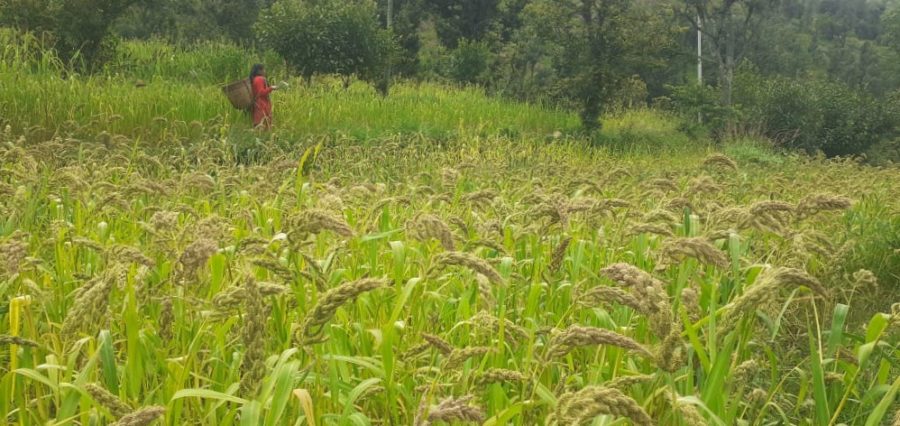
Deforestation – Effects on Biodiversity – The Impact of Chemicals – The COP 26 –
The False Promise of ‘Nature-based Solutions’ – The False Promise of Fake food –
Carbon capture and net-zero – Geo-engineering –
The Role of Biodiversity and Agroecological Systems
–
The climate emergency we face today is part of several interlocking crises involving our health, our soils, and the biodiversity on the planet. The same line of thinking and actions that are driving climate change is leading to biodiversity loss and extinction of species and has also created the current hunger, malnutrition, and health emergencies. The climate crisis is a symptom of the broader ecological crisis being perpetuated by an extractivist and profit-driven system.
Climate change and its very real consequences cannot be addressed without recognizing the central role of the industrial and globalized food system in both contributing to and perpetuating the climate crisis, but also in creating vulnerabilities in global agri-food systems. Being at the heart of the industrial food model, fossil fuels are used in almost every phase of the food chain from fossil-fuel-based chemicals in the form of pesticides or synthetic fertilizers, gas-guzzling farm equipment, and a massive fossil-fuel-based global processing, packaging, and transport system. This industrial system is also characterized by the use of commercial hybrid or GMO seeds, high water usage, monocultural cultivation which relies on the use of chemicals, concentrated animal feeding operations (CAFOs), land-use change resulting in large-scale deforestation, all funneling into the global processing and export market which creates huge amounts of food waste.
Together, these ecologically destructive practices account for 44% to 57% of all greenhouse gas emissions (GHG), making the global food system one of the main culprits behind climate change and environmental degradation.
Agriculture is also the human activity most vulnerable to climate change because it relies on the delicate balance of multiple ecosystem services, such as water, temperature, and gases such as carbon dioxide and methane in the atmosphere – natural processes that have all been affected. It has been observed that large plantations can lead to more insect outbreaks due to the expansion of monocultures at the expense of natural vegetation, directly affecting the abundance and diversity of natural enemies of insect pests. Soils treated with chemical fertilizers and emptied of organic matter lose the ability to retain water, making these areas more vulnerable to droughts and floods. Under the current global food model, long-distance food supply chains add to the vulnerability of our food systems. Food processing, packaging, and the immense transport infrastructure add to the use of fossil fuels causing food to become increasingly vulnerable to sudden changes in temperature, extreme weather events, or supply chain disruptions, as has occurred during the coronavirus pandemic.
Deforestation
The climate crisis is the result of indifference and blindness to the earth’s living systems bolstered by a profit-driven mentality[1]. This same mentality has driven agribusiness to invade forests and other vital ecosystems, making the industry responsible for 70% to 90% of global deforestation[2]. Ecosystems like the Amazon rainforest represent the lungs and liver of our planet and play a vital role in regulating the earth’s temperature, while also being able to capture carbon from the atmosphere. Yet, seemingly oblivious to this fact, agribusiness has sought the perpetual amplification of the agricultural frontier effectively displacing indigenous populations and provoking the ecocide of the most important ecosystems on the planet.
Cleared forest lands are in turn converted into chemically intensive monocultures of commodity crops such as maize, soy, palm oil, sugarcane, and cotton, to name a few. These crops are then not used to feed people, but instead are used in industrialized processed foods, for biofuels, or animal feed for industrial animal production – all creating multiple vicious cycles of GHG emissions[3].
Effects on Biodiversity
In addition to the ecological devastation occurring, agrobiodiversity is also among the main victims of the modern agricultural paradigm. Today, around 80% of the world’s arable land is organized in monocultures containing uniform and genetically identical crops which are cultivated according to highly mechanized and chemically intensive farming methods.[4] This has caused an unprecedented extinction of both agro-biodiversity and wild biodiversity, rendering ecosystems, as well as food security all the more vulnerable to climate change. For example, today only nine species account for 66% of total crop production, and three species– maize wheat, and rice– provide 60% of our daily calories[5]. The reduction of diets has led us to consume around 200 species out of the over 6,000 edible, cultivated varieties identified, with the great majority of people now only consuming around twelve plant species and five animal species [6].
The Impact of Chemicals
The evidence is growing that artificial fertilizers have reduced soil fertility and food production and contributed to desertification, water scarcity, and, therefore, climate change[7]. Soils treated with chemical fertilizers and emptied of organic carbon and nutrients lose the ability to retain water, making these areas more vulnerable to droughts and floods. They also create a perpetual need for the use of more water and more chemicals to replace nutrient depletion. This has compounding effects on ecosystems, as the use of nitrogen fertilizers also leads to the pollution of water sources, drying out of land, and the destruction of soil, leading to ever more use of fossil fuel-based pesticides, and fertilizers.
The fossil fuel-intensive agricultural model is directly responsible for a large part of the ecological degradation and hence also the climate and health emergencies experienced today. Industrial agriculture has destroyed soils, the destruction of water resources through the pollution of our lakes, rivers, and oceans, 93% of the disappearance or reduction of crop diversity, and the extinction of wild biodiversity. The combination of these factors has triggered a global climate crisis and become an international concern.
The COP 26
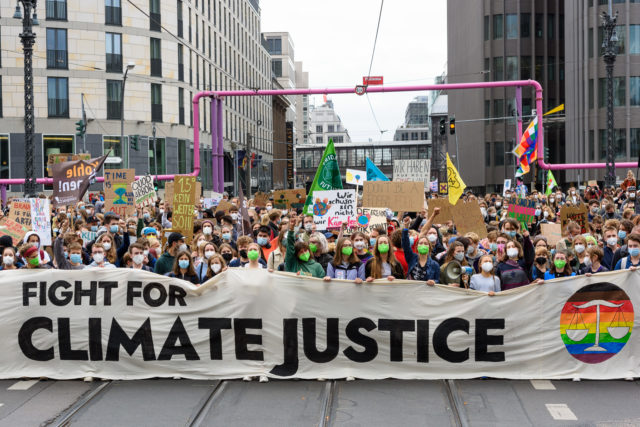
Greta Thunberg und Luisa Neubauer demonstrieren mit Fridays For Future, Berlin, Friedrichstraße, 24.09.21, by Stefan Müller, is licensed under CC BY 2.0
In the face of the looming climate emergency, world leaders from over a hundred nations are gathering at the Conference of the Parties 26 (COP26) in Glasgow from the 31st October to the 12th November 2021, to discuss our future and come up with an action plan to address climate change. Among the main objectives of the summit, which serves as the direct successor to the 2015 Paris Agreement, are commitments to increase finance in technology to augment climate resilience and reduce overall GHG emissions, to reach the 1.5°C goal by 2030. The focus on technology was expected but is also particularly worrying as it seems to suggest a further digitalization of agriculture through an increase in GMOs, biopirated and engineered climate-resilient crops, artificial and lab-grown foods, carbon credits, and other false solutions that fall short of questioning the root causes of climate change and tackling existing power structures in the food system. Many of these false solutions are financially backed by large multinationals and big tech investors who are the main culprits responsible for widespread pollution and ecocide. However, despite this, they still refuse to take responsibility for their actions and there are seemingly no mechanisms in place to hold them accountable.
Given this focus on technology and with public-private partnerships, it appears that the COP26 will mark yet another failed attempt at holding polluting companies responsible for their actions, hence playing directly into their hands and blindly complying with the fake solutions to climate change they are advocating. We are already starting to see how companies and big tech investors like Bill Gates are using these techno-fix solutions to set their own agenda for solving the climate crisis, creating new carbon markets along the way, and finding clever ruses to continue polluting while tightening their grip on the world’s resources. COP26 will likely follow suit and serve as a corporate greenwashing arena to reframe big tech and industrial agriculture as the heroes providing solutions to climate change, instead of rightfully branding them as the villains.
Already one week in, the COP26 has been branded the most exclusive conference on climate to date and received a lot of backlash from activists and civil society groups, questioning its legitimacy. Among the many protesters that took to the streets of Glasgow to voice their displeasure, the COP26 coalition managed to mobilize over 100,000 people and incited over 300 demonstrations worldwide to denounce fake solutions to climate change and ask for greater participation in climate justice.
A crucial aspect of the COP is the presence of NGOs and civil society groups during negotiations between state leaders because it serves as an opportunity for them to ensure negotiations are proceeding transparently and make sure they reflect the interests of marginalized communities that are most affected by climate change. Moreover, it also enables them to call out polluting nations for their actions and make governments face their responsibilities. It is therefore not surprising that news of their absence has been met with so much backlash.
Instead, most events occurred behind closed doors and featured a number of speeches from world leaders repeating the same familiar discourses about GHG reductions and climate finance. To add icing to the cake, philanthro-capitalists Jeff Bezos gave a speech vowing to donate 2 billion for the restoration of nature and transforming food systems. The fact that the floor is given to philanthropists and big tech investors instead of civil society groups and marginalized communities perfectly illustrate the COP26’s engaged position, and commitment to technological fixes over regenerative, biodiversity-centric solutions.
The False Promise of ‘Nature-based Solutions’
The solutions proposed by these climate villains, in response to the imminent climate crisis, are costly, unproven, and often dangerous technological fixes that are geared towards replacing the very natural processes they have been destroying through the imposition of technological innovations such as artificially grown lab food, gene editing, carbon capture, carbon credits, and geoengineering. These techno-fixes completely ignore the power of nature and deny its regenerative abilities. Yet, despite this, they are being backed by multinationals and big tech investors that market them as the only possible solution to our climate predicament.
False solutions and biotech shift political power away from organic farmers and local communities toward biotech companies and large investors. They disregard local, indigenous knowledge and diverse food cultures that have evolved alongside diverse ecosystems and are thus a clever way for the companies to justify their actions and perpetuate the cycle of extractivism to increase profits and accumulate power.
The False Promise of Fake food
Among several false solutions, artificial ‘plant-based’ analogs and lab-grown foods are being promoted by agri-business and biotech, in alliance with philanthro-capitalists like Bill Gates, as a viable solution to our enduring climate emergency.
Proponents of fake food claim that it provides a real solution to climate change, and environmental degradation, due to it not needing intensive water and land resources, while also addressing concerns over animal greenhouse gas emissions and animal welfare in the admonished meat industry. However, the true purpose could not be further away from ending climate change or world hunger. These ultra-processed ‘plant-based’ foods rely on technical innovations such as synthetic biology, which involves reconfiguring the DNA of an organism to create something entirely new, and not found in nature. For instance, companies like Beyond Meat and Impossible Foods use a DNA coding sequence from soybeans or peas to create a product that looks and tastes like real meat. Some companies are also investing in cell-based meat, grown from real animal cells[8]. The result is a whole range of lab-grown fake meats, eggs, cheese, and dairy products swarming the market to ultimately replace animal products and alter modern diets.
Despite advocates claiming otherwise, research has shown that lab-produced fake foods have a larger carbon footprint than less processed plant proteins[9]. Meat analogs are up to seven times more carbon-intensive than whole pulses, and cell-based meat also emits more greenhouse gases than animal products, like pork or poultry[10]. Recent research even suggests that over the long-term, the environmental impact of lab-grown meat could be higher than that of livestock[11].

“The Impossible Burger” by T.Tseng is licensed under CC BY 2.0
Plant-based substitutes and meat analogs are by no means a move away from industrial agriculture. Even though fake food is advertised as “eco-friendly”, it is made with proteins from pea, soy, or corn that are grown on large monocultures which still rely on heavy tillage, chemical inputs, and GMOs. Ironically, these plant-based meat alternatives, which claim to save animals, water, and the environment, are instead directly contributing to the same food system that is threatening global biodiversity, destroying wildlife, altering the soils, and polluting groundwater supplies.
Lab-grown food symbolizes yet another profit-making machine used by billionaires and big corporations to increase control through patents[12]. Indeed, 20 patents have been assigned to Impossible Foods, with over 100 additional patents pending for other fake meat proxies, from chicken to fish[13]. Equally worrying is the alarming rate at which these fake plant-based alternatives are expanding. In the United States, the plant-based market has already grown from 4.9 billion in 2018 to 7 billion in 2020, which represents an overall increase of 43% in dollar sales over the last two years. Similarly, the plant-based meat market is also booming, having reached a value of 1.4 billion and registered a growth of 72% by 2020. These numbers are expected to keep growing as more and more companies enter this rapidly expanding market and more big tech investors, like Bill Gates, continue channeling their money into the blossoming industry.
The patenting logic that underlies the fake food movement, sees animals and nature as disposable elements that can simply be replaced by more efficient technologies such as lab-engineered products. It thus completely ignores our relationship with nature and creates a rift separating humans from nature and food from life.
In the same vein, cows are branded as the culprits contributing to climate change by big tech investors and multinationals. Blinded by their technological dogma, these people fail to see that the symbiosis between animals and plants is essential for the renewal of soil fertility. This is why when cows feed on grass, they fertilize the soil, improve biodiversity and help with sequestering carbon into the earth[14]. On the other hand, cow’s concentrated in CAFOs (Concentrated Animal Farm Operations) are force-fed industrially grown grains and soy, contributing to the expansion of GHG emitting industrial agriculture, all while the waste of these operations is mismanaged, causing a greater release of methane and pollutions air and water sources. Evidence indicates that meat from grass-fed animals may have a much lower ecological footprint than the meat industry and plant-based fake meat alternatives[15]. Meat consumption per se is not the problem, rather it is the industrial meat production model that is responsible for the majority of GHG emissions. Therefore, the real solution does not lie in creating substitutes for food, it lies in understanding the needs of the ecosystems we are embedded in and healing our connection with nature.
Fake food concentrates the power into the hands of a few biotech companies, and away from indigenous people, farmers, and other communities, therefore invalidating their ancestral knowledge and robbing them of the possibility of defining their food systems. The introduction and patenting of plant-based diets through GMO soya and other forms of vegetable protein is a violation of food as a living system that connects us to the ecosystem and other beings and indicates ignorance of the diversity of cultures that historically have used a huge variety of plants in their diets[16]. The promise of fake food is based on a lie that does very little to question the industrialized food and farming industry. Instead, it keeps enforcing existing power structures along the food chain to fulfill profit maximization and turns a blind eye to the solutions proposed by the regenerative agriculture movement.
Carbon capture and net-zero
“Net-zero” and “carbon capture” are two solutions advocated by multinationals and billionaires that fall under the umbrella of “nature-based solutions”. Nature-based solutions are a broad concept increasingly used by corporations and world leaders to promote a range of carbon offsetting schemes for climate and biodiversity protection, that are firmly grounded in discredited market mechanisms and corporate greenwashing[17]. The concept instrumentalizes nature as the solution to the climate crisis but stops short of defining who created the problem in the first place.
In essence, the idea behind ‘Net-Zero’ is to balance out greenhouse gas emissions with removals of greenhouse gases until we are left with zero. In order to reach zero, the amount of CO2 added cannot be more than the amount taken away from the atmosphere over the same period of time. This equation is problematic in its own right because it implies that companies can achieve net-zero by investing in carbon offsetting schemes. However, net-zero will not lead to real reductions in carbon emissions for several reasons. First, net-zero focuses only on emissions flows and as such fails to consider the cumulative nature of carbon. Carbon dioxide remains in the atmosphere for hundreds to thousands of years, unless it is stored elsewhere, meaning that past, present, and future emissions will have a cumulative impact on both global warming and ocean acidification. Second, net-zero is based on a lie because offsets do not actually reduce atmospheric concentrations of CO2[18]. CO2 levels will thus continue to rise at an alarming pace if they are not effectively sequestered by the soils and oceans.
During Navdanya International’s latest webinar on regeneration, Andre Leu, former president of IFOAM, stressed that achieving net-zero would do very little to solve the catastrophic effects of climate change due to the cumulative buildup of carbon already affecting climate cycles. Instead, we should be aiming towards reaching “negative zero” or “real zero” by building up soils through active carbon sequestration through regenerative agroecology.
Download images – Download pdf
In reality, ‘net-zero’ is nothing more than an elaborate corporate greenwashing scheme that grants polluting companies the right to expand their activities and continue polluting as usual, as long as they can claim to sequester carbon elsewhere. By offsetting their emissions through planting monoculture tree plantations, companies will thus continue to provoke land grabbing and displacement of communities, human rights violations, water scarcity, and further biodiversity loss.
These so-called “nature-based solutions” are a euphemism deliberately made to sound attractive to distract us from the root causes of the climate and health crisis. The term acts as a dangerous delay tactic, which allows corporations, governments, and financial institutions to continue business as usual, without fundamentally addressing the root causes of the climate crisis. Nature-based solutions instrumentalize nature by using the transactional logics of market mechanisms, all while externalizing ecological destruction and perpetuating neocolonial dispossession of indigenous populations, peasants, and many other communities through carbon offset projects. If left unchecked, these tactics will continue to exacerbate the crises by bolstering inequality and corporate power.
Geo-engineering
Geoengineering is yet another false solution that is gaining more and more traction. The idea behind geoengineering is to deploy a range of technologies to deliberately intervene in the earth’s climate system and effectively alter it[19]. For example, the Bill and Melinda Gates Foundation and Harvard University are working together to finance a plan that would put sulfate aerosols into the atmosphere to block the sun. In theory, blocking incoming sunlight through chemicals would reduce the issue of global heating, thus granting us control over the climate.
Yet, there are many risks associated with this technology as blocking sunshine will reduce photosynthesis, reduce the biosphere’s capacity to absorb carbon dioxide, and, as a consequence, reduce the production of food[20]. Moreover, blocking sunshine is also likely to prevent the creation of Vitamin D, and Sulphate aerosols will mix with water, oxygen, and other chemicals to form acid rain.[21].
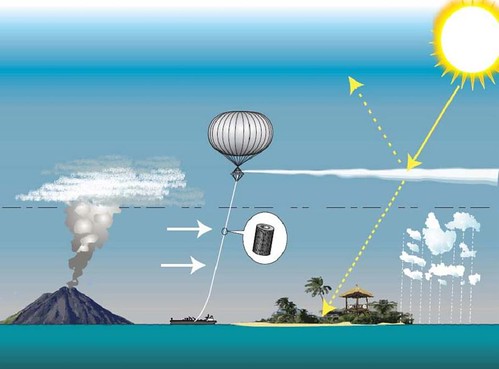
Solar Geoengineering blocks sunlight through the spraying of sulfate aerosols. “SPICE Geoengineering SRM” by rezn8d is licensed under CC PDM 1.0
Then, there is also the fact that carbon dioxide’s heating effect on the atmosphere can persist for up to 10,000 years or more. The sun-dimming particles are believed to drop out of the atmosphere after roughly a year, meaning that in order for this technology to be effective you need to essentially keep this process up forever and continuously pump the atmosphere with chemical aerosols. Should we go down this path, there is no telling what would happen if we were suddenly forced to stop. Needless to say, the effects could be catastrophic and we could be left with a century’s worth of carbon dioxide accumulating in the atmosphere.
Given that climate change through geoengineering would have to be undertaken each year to be successful, this would also create a new market for billionaires. According to evidence from Jennie Stephens and Kevin Surprise, this false solution would need around 95 aircraft flying 41 flights per day, (60,109 flights per year) to deliver 1.5 billion tonnes of sulfur to the lower stratosphere for a cost of approximately $36 billion.[22]
Geoengineering by definition aims to deliberately alter planetary boundaries such as the carbon cycle and hydrological cycle but does not aim to address the root causes of climate change. Therefore, it holds the risk of worsening the climate, as too little is known about the functioning of the planetary ecosystem as a whole. Manipulating the atmosphere and the earth’s climate through the diffusion of aerosols is not only a recipe for more pollution, but it is also a denial of the sun’s capacity to provide our planet with life and energy and regulate the earth’s climate[23]. Solar geoengineering thus perfectly symbolizes humanity’s denial of existing natural processes. It is a manifestation of the hubris that sees man above nature and that all problems can be solved through technological interventions[24].
The solutions exposed above are a product of a mechanistic worldview that sees nature as dead and inert matter that can be engineered and manipulated to fit our needs and bolster corporate greed[25]. By placing technological innovations on a pedestal and branding them as the only possible option for solving the world’s many crises, the big corporations are setting their own agenda and further cementing their control, while robbing societies of the ability to see and think of other options. In so doing, they are obscuring the real root causes of the crises we face and bringing us down a dangerous path of further unprecedented crises. This reluctance to address systemic issues is by no means accidental, rather, it is a deliberate attempt by giant multinationals to maintain their control by perpetuating the same power structures that created our current crises, without taking responsibility for the large-scale pollution and environmental degradation they have caused in the first place.
This is not the transition that we need. The goal should not be only sequestering carbon, but the overall health of ecosystems and people, the generation of livelihoods, and healthy economies and the creation of equity and justice. We need to protect our forests, safeguard biodiversity and therefore build health and climate resilience. We need to stop seeing the earth as dead and recognize that it is alive, and that nature cycles carbon to create life.
The Role of Biodiversity and Agroecological Systems
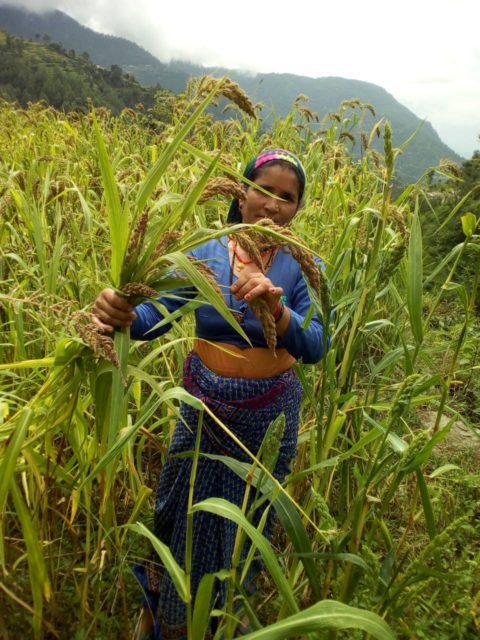
Photo: Navdanya
Unlike the false promises that are being pursued by corporations and billionaire investors, real solutions to climate change should not seek to engineer or manipulate our planet for profit and control. On the contrary, they should aim to work alongside nature to restore its biodiversity and rejuvenate its natural cycles. These solutions already exist and are being pushed by local, diverse food communities around the world, showing us that it is possible to walk a path of living in harmony with nature. Biodiversity of plants, animals, and microorganisms are key to providing the stability and balance necessary to create resilient agroecosystems in the face of climate change. The same food and agriculture systems that conserve and rejuvenate biodiversity also mitigate climate change and contribute to health and increased livelihoods through regenerative, living economies.
Agroecology is based on a broad set of principles and includes diverse ways of farming with nature and rejuvenating biodiversity through living seed, soil, and local food communities, without the use of fossil-fuel-based chemicals[26]. Agroecological systems are designed to mimic natural processes and to regenerate biodiversity to provide ecological services such as natural pest control, nutrient cycling, rejuvenated and growing soils, increased carbon sequestration, and a higher concentration of water in soils[27]. By focusing on the local and shifting production away from globalized supply chains, such systems can eliminate fossil-fuel intensive methods and replace them with low input, regenerative ones that strengthen the soil and fix carbon dioxide back into it. This helps agroecosystems retain their climate regulatory functions and mitigate the effects of climate change.
Increasing genetic diversity, as well as crop diversification, is central to the agroecological approach to farming to reduce vulnerability to floods, droughts, and other unpredictable weather extremes[28]. In the fields, this diversity translates into a variety of methods such as seasonal crop rotations and multi-cropping. As opposed to monocultures, which feature at best one variety of a crop, multispecies systems consist of several crop species growing simultaneously on the same field[29]. Research shows that crop diversity on farms reduces crop vulnerability to specific diseases and pests, and results in higher yields when compared to monocultures[30].
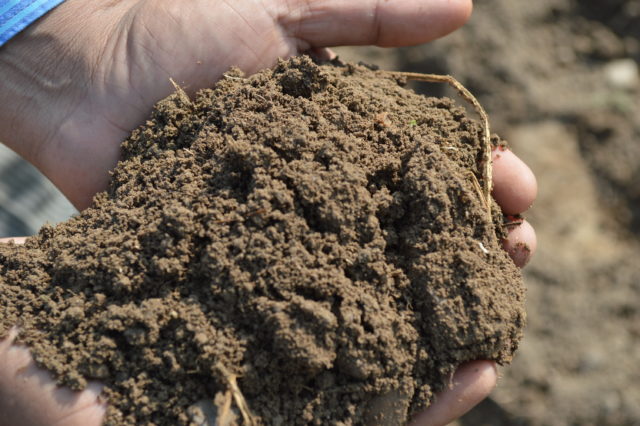
Photo: Navdanya
A transition to organic, regenerative farming should be the top priority. By working alongside nature, regenerative, agroecological farming can generate greater food resilience while drawing down carbon from the atmosphere and putting it back into the soil through photosynthesis[31]. Increasing the sequestration of carbon in soils is a vital aspect of climate change mitigation. By increasing carbon absorption, organic farming has a lower climate impact than industrial chemical agriculture. Regenerative, agroecological farming practices have the potential to sequester 52 gigatons of carbon dioxide, as they can harvest 733- 3000 kg or more of carbon dioxide per hectare, per year from the atmosphere, equivalent to the amount needed to stay below the 2 degree centigrade range[32].
Agroecological solutions to climate change represent a move away from the industrial food system and embrace a different vision of food system transformation. They are based on a systemic approach, a deep understanding of living, and involve a transformation at the political, social, and economic level. Agroecological transformation is incompatible with the industrial agriculture paradigm, as it requires a complete shift away from the hyper-centralized, corporate-controlled industrial food system. Any compromise, such as the borrowing of a few ecological techniques and practices that would not modify the monoculture model of industrial agriculture, may only moderate negative impacts temporarily, while directly contributing to further climate crises in the long run. True transformation can thus only happen through a shift to agroecological farming and food systems.
References:
[1] Earth Democracy: Connecting the Rights of Mother Earth to People’s Rights and the Well-being of All, Dr Vandana Shiva and Navdanya Team, 2021, https://www.navdanya.org/site/earth-university/connecting-rights-of-mother-earth
[2] Food and Climate Change: The Forgotten Link.” Grain, September 28, 2011. https://www.grain.org/e/4357
[3] Ibid.
[4] Altieri, Miguel A., and Clara I. Nicholls. 2020. Agroecology and the reconstruction of a post-COVID-19 agriculture. The Journal of Peasant Studies 47 (5): 881–898. https://doi.org/10.1080/03066150.2020.1782891.
[5] Ceccarelli, Salvatore. 2019. Nurturing diversity in our guts and on our farms to reduce health risks and increase food system resilience. The Future of Food, 45–51. Rome, Italy: Navdanya International. https://navdanyainternational.org/publications/the-future-of-food-farming-with-nature-cultivating-the-future/.
FAO, and Commission on Genetic Resources for Food and Agriculture. 2019. In The State of the World’s Biodiversity for Food and Agriculture, ed. J. Bélanger and D. Pilling. Rome: Food and Agriculture Organization of the United Nations. http://www.fao.org/3/CA3129EN/CA3129EN.pdf.
[6] FAO, and Commission on Genetic Resources for Food and Agriculture. 2019. In The State of the World’s Biodiversity for Food and Agriculture, ed. J. Bélanger and D. Pilling. Rome: Food and Agriculture Organization of the United Nations. http://www.fao.org/3/CA3129EN/CA3129EN.pdf.
[7] Shiva V. “Plants, Planet & People”, Navdanya 2021, https://www.navdanya.org/site/plants,-planet-people
[8] Saigol, Lina and Keown, Callum. ‘Is Cell-Based Meat the Next Big Thing? Here Are 5 Companies Leading the Revolution’. MarketWatch, Oct. 8, 2020. https://www.marketwatch.com/story/is-cell-based-meat-the-next-big-thing-here-are-5-companies-leading-the-revolution-2020-10-06
[9] Santo, Raychel E., et al. ‘Considering Plant-Based Meat Substitutes and Cell-Based Meats: A Public Health and Food Systems Perspective’. Frontiers in Sustainable Food Systems, vol. 4, Aug. 2020, p. 134. https://doi.org/10.3389/fsufs.2020.00134
[10] Muraille, Eric. ‘“Cultured” Meat Could Create More Problems than It Solves’. The Conversation, Nov. 28, 2019. http://theconversation.com/cultured-meat-could-create-more-problems-than-it-solves-127702
[11] Ibid.
[12] Itzkan, Seth. “Opinion: Software to Swallow — Impossible Foods Should Be Called Impossible Patents.” Medium. Last modified May 27, 2020. https://medium.com/@sethitzkan/opinion-software-to-swallow-impossible-foods-should-be-called-impossible-patents-71805ecec9de
[13] Patents Assigned to Impossible Foods Inc. Justia Patents Search. https://patents.justia.com/assignee/impossible-foods-inc
[14] Ibid.
[15] Comparative Environmental LCA of the Impossible Burger with Conventional Ground Beef Burger’, Quantis, Feb. 2019.https://assets.ctfassets.net/hhv516v5f7sj/4exF7Ex74UoYku640WSF3t/cc213b148ee80fa2d8062e430012ec56/Impossible_foods_comparative_LCA.pdf
‘Carbon Footprint Evaluation of Regenerative Grazing at White Oak Pastures’, Quantis, Feb. 2019. https://blog.whiteoakpastures.com/hubfs/WOP-LCA-Quantis-2019.pdf
Reeder, J. D., and G. E. Schuman. ‘Influence of Livestock Grazing on C Sequestration in Semi-Arid Mixed-Grass and Short-Grass Rangelands’. Environmental Pollution, vol. 116, no. 3, Mar. 2002, pp. 457–63. https://doi.org/10.1016/S0269-7491(01)00223-8
[16] Shiva, V. Fake Food, Fake Meat: Big Food’s Desperate Attempt to Further the Industrialisation of Food.” Navdanya International, 18 June 2019
[17] Nature Based Solutions: A Wolf in Sheep’s Clothing.” Friends of the Earth International, 27 Oct. 2021, https://www.foei.org/news/nature-based-solutions-a-wolf-in-sheeps-clothing
[18] Ibid.
[19] Why SRM Experiments Are a Bad Idea’. ETC Group, 28 Mar. 2017, https://www.etcgroup.org/content/why-srm-experiments-are-bad-idea
[20] Shiva V. “Plants, Planet & People”, Navdanya 2021, https://www.navdanya.org/site/plants,-planet-people
[21] Ibid.
[22] Stephens, Jennie C., and Kevin Surprise. ‘The Hidden Injustices of Advancing Solar Geoengineering Research’. Global Sustainability, vol. 3, 2020. www.academia.edu, https://www.academia.edu/41613765/The_Hidden_Injustices_of_Advancing_Solar_Geoengineering_Research
Ibid.
[23] Shiva V., Carbon Capture’: Two World Views, Two Technology Paradigms, Two Economic Systems, Two Futures.” Navdanya, Oct. 2021, https://www.navdanya.org/bija-refelections/2021/10/06/carbon-capture/
[24] ‘Hands Off Mother Earth! Manifesto Against Geoengineering’. Geoengineering Monitor, 4 Oct. 2018, https://www.geoengineeringmonitor.org/2018/10/hands-off-mother-earth-manifesto-against-geoengineering/
[25] Shiva V., Carbon Capture’: Two World Views, Two Technology Paradigms, Two Economic Systems, Two Futures.” Navdanya, Oct. 2021, https://www.navdanya.org/bija-refelections/2021/10/06/carbon-capture/
[26] Altieri, Miguel A. “The Ecological Role of Biodiversity in Agroecosystems.” Agriculture, Ecosystems & Environment, vol. 74, no. 1, June 1999, pp. 19–31. ScienceDirect, https://doi.org/10.1016/S0167-8809(99)00028-6.
[27] Lim Li Ching, Agroecology for Sustainable Food Systems, G-STIC 2017 –Agroecology summary – Final version – January 2018] https://www.twn.my/title/end/pdf/end19.pdf – https://ali-sea.org/aliseaonlinelibrary-dashboard/get/file/G-STIC-2017-%E2%80%9CAgroecology-for-Sustainable-Food-Systems%E2%80%9D.pdf
[28] Ibid.
[29] From Uniformity to Diversity: A paradigm shift from industrial agriculture to diversified agroecological systems, iPES FOOD, 2016, http://www.ipes-food.org/_img/upload/files/UniformityToDiversity_FULL.pdf
[30] Pimentel D., Hepperly P., Hanson J., Douds D., Seidel R. (2005) – Environmental energetic, and economic comparisons of organic and conventional farming systems. “Bioscience”, 55, pp.573-582.
[31] Ibid.
[32] Regenerative Organic Agriculture and Climate Change A Down-to-Earth Solution to Global Warming, Rodale Institute, 2015, https://rodaleinstitute.org/wp-content/uploads/rodale-white-paper.pdf – Fließbach A., Oberholzer H.-R., Gunst L., Mäder P. (2007) – Soil organic matter and biological soil quality indicators after 21 years of organic and conventional farming. “Agriculture ecosystems & Environment”, 118, pp. 273-284; Pimentel D., Hepperly P., Hanson J., Douds D., Seidel R. (2005) – Environmental energetic, and economic comparisons of organic and conventional farming systems. “Bioscience”, 55, pp. 573-582.
Additional links
Bill Gates & His Fake Solutions to Climate Change, Navdanya International, 2021
Gates Ag One: The Recolonisation Of Agriculture, Navdanya International, 2020
Pact for the Earth, Navdanya International, 2015
Plants, Planet & People – The Living Earth and Climate Change, Dr Vandana Shiva, Navdanya, October 2021
Shroff, R., Cortés, C.R. The Biodiversity Paradigm: Building Resilience for Human and Environmental Health. Development 63, 172–180 (2020). https://doi.org/10.1057/s41301-020-00260-2
The law of the seed, International Commission on the Future of Food and Agriculture. Navdanya International. 2013
